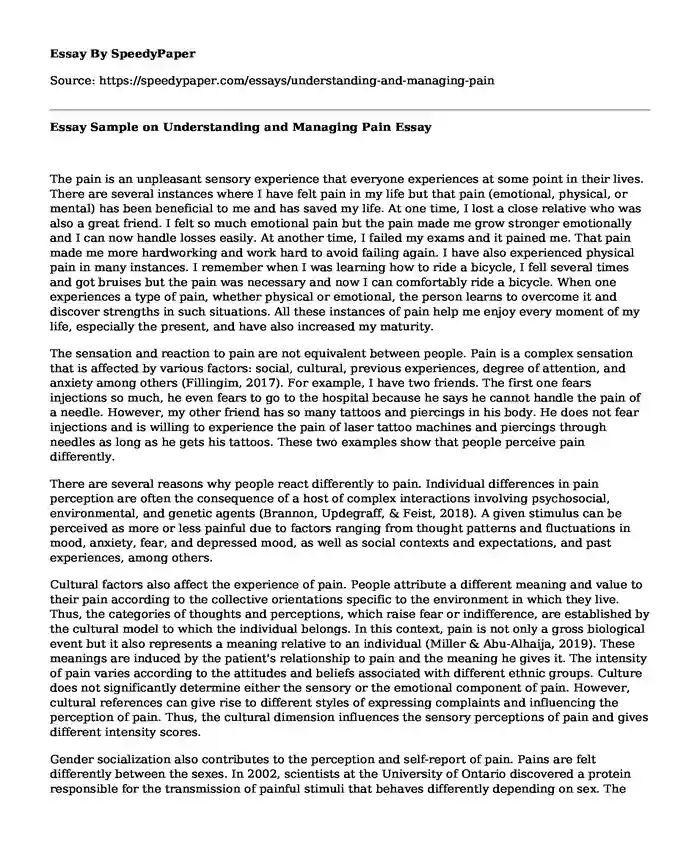
| Essay type: | Process essays |
| Categories: | Personal experience Human behavior Emotional intelligence |
| Pages: | 3 |
| Wordcount: | 752 words |
The pain is an unpleasant sensory experience that everyone experiences at some point in their lives. There are several instances where I have felt pain in my life but that pain (emotional, physical, or mental) has been beneficial to me and has saved my life. At one time, I lost a close relative who was also a great friend. I felt so much emotional pain but the pain made me grow stronger emotionally and I can now handle losses easily. At another time, I failed my exams and it pained me. That pain made me more hardworking and work hard to avoid failing again. I have also experienced physical pain in many instances. I remember when I was learning how to ride a bicycle, I fell several times and got bruises but the pain was necessary and now I can comfortably ride a bicycle. When one experiences a type of pain, whether physical or emotional, the person learns to overcome it and discover strengths in such situations. All these instances of pain help me enjoy every moment of my life, especially the present, and have also increased my maturity.
The sensation and reaction to pain are not equivalent between people. Pain is a complex sensation that is affected by various factors: social, cultural, previous experiences, degree of attention, and anxiety among others (Fillingim, 2017). For example, I have two friends. The first one fears injections so much, he even fears to go to the hospital because he says he cannot handle the pain of a needle. However, my other friend has so many tattoos and piercings in his body. He does not fear injections and is willing to experience the pain of laser tattoo machines and piercings through needles as long as he gets his tattoos. These two examples show that people perceive pain differently.
There are several reasons why people react differently to pain. Individual differences in pain perception are often the consequence of a host of complex interactions involving psychosocial, environmental, and genetic agents (Brannon, Updegraff, & Feist, 2018). A given stimulus can be perceived as more or less painful due to factors ranging from thought patterns and fluctuations in mood, anxiety, fear, and depressed mood, as well as social contexts and expectations, and past experiences, among others.
Cultural factors also affect the experience of pain. People attribute a different meaning and value to their pain according to the collective orientations specific to the environment in which they live. Thus, the categories of thoughts and perceptions, which raise fear or indifference, are established by the cultural model to which the individual belongs. In this context, pain is not only a gross biological event but it also represents a meaning relative to an individual (Miller & Abu-Alhaija, 2019). These meanings are induced by the patient's relationship to pain and the meaning he gives it. The intensity of pain varies according to the attitudes and beliefs associated with different ethnic groups. Culture does not significantly determine either the sensory or the emotional component of pain. However, cultural references can give rise to different styles of expressing complaints and influencing the perception of pain. Thus, the cultural dimension influences the sensory perceptions of pain and gives different intensity scores.
Gender socialization also contributes to the perception and self-report of pain. Pains are felt differently between the sexes. In 2002, scientists at the University of Ontario discovered a protein responsible for the transmission of painful stimuli that behaves differently depending on sex. The GIRK2 protein plays a fundamental role in pain sensation and resistance to analgesics in men (Packiasabapathy & Sadhasivam, 2018). This does not happen, however, with women. Experiments have shown that women are more able to distinguish regions with pain, a lower threshold of pain perception, and less tolerance to induced pain stimuli than men. In experimental pain, greater femininity or female social roles seem to be associated with lower pain tolerance thresholds and less pain tolerance, as well as a greater propensity to communicate the painful sensation.
References
Brannon, L., Updegraff, J. A., & Feist, J. (2018). Health psychology: An introduction to behavior and health (9th ed.). Boston, MA: Cengage Learning. https://duranbooks.net/shop/health-psychology-an-introduction-to-behavior-and-health-9th-edition-ebook/
Fillingim, R. B. (2017). Individual differences in pain: understanding the mosaic that makes pain personal. Pain, 158(1), 11-18. https://dx.doi.org/10.1097%2Fj.pain.0000000000000775
Miller, E. T., & Abu-Alhaija, D. M. (2019). Cultural Influences on Pain Perception and Management. Pain Management Nursing, 20(3), 183-184. https://doi.org/10.1016/j.pmn.2019.04.006
Packiasabapathy, S., & Sadhasivam, S. (2018). Gender, genetics, and analgesia: understanding the differences in response to pain relief. Journal of pain research, 11, 2729. https://dx.doi.org/10.2147%2FJPR.S94650
Cite this page
Essay Sample on Understanding and Managing Pain. (2023, Aug 30). Retrieved from https://speedypaper.com/essays/understanding-and-managing-pain
Request Removal
If you are the original author of this essay and no longer wish to have it published on the SpeedyPaper website, please click below to request its removal:
- Free Essay on the Representation of Women in Grime Music
- Essay Example on "What Is Intersectionality and Why Do I Need It" by Ijeoma Oluo
- Essay Sample on Homelessness and Poverty
- The Potential Market Segments for the Toyota Motor Corporation. Free Essay
- Free Essay: African American History Across Social-Cultural Perspective
- Free Essay: Case Evaluation of Cross-Cultural Management
- Interventions for Depression Amongst Australian Prison Inmates. Essay Example
Popular categories




